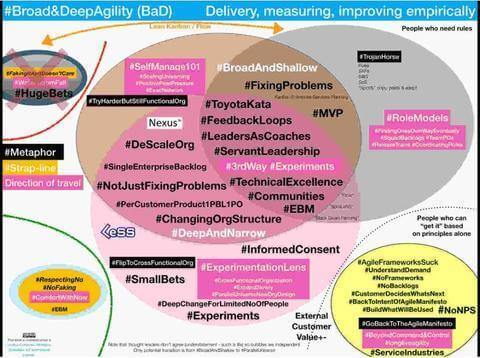2 min read
Updated: Nov 6, 2018
In my Broad and Deep agility (BaDa) strategy, Nexus (without Scrum Studio), Scrum @ Scale or SAFe or Spotify copy paste & adapt or ING copy paste & adapt could be the Broad & Shallow approach, a holding pattern to limit the onset of Zombie Scrum.
Nexus delivers better value faster, the others deliver faster, with assumptions about value from bets/business cases. Sometimes negative value is delivered. And that is why I prefer to use Nexus (unofficially pairing with other techniques like customer segmentation from Flow-Academy.org or other ways of achieving Black Swan Farming like say (Professional Scrum with ) Kanban or Lean Kanban ).

So what is Broad & Shallow? Broad & Shallow is the bringing about of agility for the masses without changing from a functional organization to a cross-functional organization; it is very useful when there is a huge appetite for change but not yet sufficient demand for flipping the organization more of less upside down with teams hiring their (optional) line managers. With Broad & Shallow (not without its challenges) we can get hundred or thousands of people to start with agility but there is often a lack of depth particularly for Trojan Horse approaches.
Trojan Horses are good in that they help an organization to step-change; examples include Scrum @ Scale or SAFe or Spotify copy paste & adapt or ING copy paste & adapt. Trojan Horses are useful for "projectland". We can expect to deliver faster, but adaptiveness is out of reach still. The only "try harder" (deprecate traditional roles, getting away from projects more and more) approach in the Broad & Shallow arena is Nexus.
I find that a Deep & Narrow approach is needed to attain adaptiveness that has less chance of retracting to functional silo normlaity after problems are solved (listen to Jeff Sutherland/Darrell Rigby June 2018 podcast), where team members are measured on their number of materially different skills and how many skills they can coach others on, where shared profit replaces individual bonuses, where trending measures even when gamed lead to good outcomes, where annual budgets are a thing of the past, where functional silos are replaced with self-managing long-term stable teams, where teams can flex to other areas of the product because they continue to multi-learn on the customer/end-user domains and the technical domain. Metaphorically, Deep & Narrow is a way to get to authentic (agility) growth like a fresh walk in springtime through the forest of Fontainebleau in the smell of the place.
I want to give credit to Rob Patton for the satellites idea, growing satelittes of good deep agility rather than a growing "parallel universe". I see potential in the satellites idea that Rob is trialing, in a similar way to using the boy scouts rule "leave it better than you found it" eventually eradicates technical debt.
This work is licensed under a Creative Commons Attribution-NonCommercial-NoDerivatives 4.0 International License.
https://linktr.ee/johncolemanxagility - social and podcast links
https://linkpop.com/orderlydisruption - order training from right here

